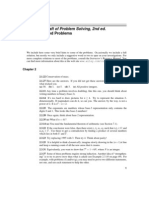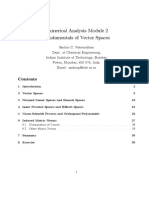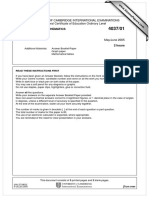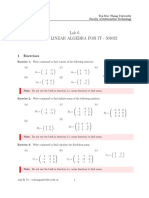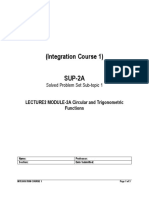HW 2
HW 2
Uploaded by
Yuhua WangCopyright:
Available Formats
HW 2
HW 2
Uploaded by
Yuhua WangOriginal Description:
Original Title
Copyright
Available Formats
Share this document
Did you find this document useful?
Is this content inappropriate?
Copyright:
Available Formats
HW 2
HW 2
Uploaded by
Yuhua WangCopyright:
Available Formats
Math 53 Homework 2
Due Tuesday 9/13/11 in section
(The problems in parentheses are for extra practice and optional. Only turn in the underlined problems.) Wednesday 9/7 Dot product continued; determinant Read: section 12.3. Work: 12.3: (1), (11), 19, 23, (25), (27), (34), 35, (39), (45), (51), 56, 59, (60). Problem 1 below. Friday 9/9 Cross product Read: section 12.4. Work: 12.4: (3), (9), (13), 16, (19), (27), 31, 35, (37), (43), 44, 49. p. 794 The geometry of a tetrahedron, parts 1 and 3. Hint: for part 1, dont introduce coordinates; instead, express everything in terms of the vectors a = SP , b = SQ , and c = SR and use vector identities.
Problem 1. The eight vertices of a cube centered at (0, 0, 0) of side length 2 are at (1, 1, 1). a) Find the four vertices of the cube, starting with (1, 1, 1), that form a regular tetrahedron. Conrm your answer by nding the length of an edge and explaining why all edges have the same length. (Recall: a tetrahedron is a solid with four triangular faces, like a pyramid with a triangular base; it is regular if all faces are equilateral triangles. Draw pictures and look at cubical objects in order to gure out how equilateral triangles t on a cube). b) Use dot product to nd the angle between two adjacent edges (edges sharing a common vertex) of the regular tetrahedron; and the angle between two opposite edges (edges that lie on skew lines; even though they dont intersect, you can still compute the angle made by their directions). Explain your answers using symmetry. c) A methane molecule CH4 consists of a hydrogen atom at each of the vertices of a regular tetrahedron and a carbon atom at the center. Find the bond angle, i.e. the angle made by vectors from the carbon atom to two hydrogen atoms (use a calculator; round your answer).
You might also like
- 2.12.4 Test (TST) - Triangles (Test)Document10 pages2.12.4 Test (TST) - Triangles (Test)Charlotte Hargrove100% (2)
- Paul Zeitz - Hints To Selected ProblemsDocument14 pagesPaul Zeitz - Hints To Selected ProblemsuncristiNo ratings yet
- Numerical Analysis Module 2 Fundamentals of Vector SpacesDocument33 pagesNumerical Analysis Module 2 Fundamentals of Vector Spacespartha4uNo ratings yet
- Motion GraphsDocument2 pagesMotion Graphsjerald vernon torresNo ratings yet
- Experiment 1: To Study 2D Bravais Space Lattices Maximum Marks: 25Document3 pagesExperiment 1: To Study 2D Bravais Space Lattices Maximum Marks: 25Kevin StraceyNo ratings yet
- Geometry Worksheet 1 - AnglesDocument13 pagesGeometry Worksheet 1 - AnglesAlexaNo ratings yet
- Acps HintsDocument11 pagesAcps Hintssatan catNo ratings yet
- Computational Topology Homework 1Document2 pagesComputational Topology Homework 1Govind GopakumarNo ratings yet
- Homework 1. This Homework Is Based On Chapters: Problem 1Document4 pagesHomework 1. This Homework Is Based On Chapters: Problem 1Iqra WahidNo ratings yet
- 03 Award in Algebra Level 3 Practice PaperDocument22 pages03 Award in Algebra Level 3 Practice PaperAlexFryNo ratings yet
- Experiment 1: To Study 2D Bravais Space Lattices Maximum Marks: 25Document3 pagesExperiment 1: To Study 2D Bravais Space Lattices Maximum Marks: 25Kushagra GuptaNo ratings yet
- Math PracticeDocument25 pagesMath PracticeYoon Myat EaimNo ratings yet
- Conic SectionsDocument35 pagesConic SectionsGina Fe S. LegaspiNo ratings yet
- Q3 Grade 8 Week 7Document16 pagesQ3 Grade 8 Week 7aniejeonNo ratings yet
- INPHO Question Paper 04-02-2024Document9 pagesINPHO Question Paper 04-02-2024Safiqul IslamNo ratings yet
- Recurring Crux Configurations 8 Heronian Triangles 38.8Document3 pagesRecurring Crux Configurations 8 Heronian Triangles 38.8ŁØNɆ ⱲØŁꞘNo ratings yet
- H 1Document3 pagesH 1MD SIAMNo ratings yet
- Mathpp 2Document15 pagesMathpp 2Benjamin mwanikiNo ratings yet
- AFEM Ch09Document22 pagesAFEM Ch09Kim Novis50% (2)
- November 2012 Question Paper 11 PDFDocument4 pagesNovember 2012 Question Paper 11 PDFprsara1975No ratings yet
- M M M M: Plus Homework TimeDocument4 pagesM M M M: Plus Homework Timeapi-287224366No ratings yet
- Directions: Consider The Table Below. Given Each Figure, Recall The Definition of Each Quadrilateral and Write It On The Space ProvidedDocument19 pagesDirections: Consider The Table Below. Given Each Figure, Recall The Definition of Each Quadrilateral and Write It On The Space ProvidedJaninne Villa Del ReyNo ratings yet
- If KnownDocument28 pagesIf Knownjain.radha.aggrNo ratings yet
- 2022 - Maths - Revision Assignment - GR 7eDocument7 pages2022 - Maths - Revision Assignment - GR 7eRolandi ViljoenNo ratings yet
- Engineering Entrance Exam 2009Document5 pagesEngineering Entrance Exam 2009hoa nguyễnNo ratings yet
- Plane Figures: ROMBLON STATE UNIVERSITY - College of Engineering and Technology Pre-Calculus II - 1 Semester - 2020-2021Document5 pagesPlane Figures: ROMBLON STATE UNIVERSITY - College of Engineering and Technology Pre-Calculus II - 1 Semester - 2020-2021Noel S. De Juan Jr.No ratings yet
- Geometry, Trigonometry, Mensuration, Area, Volume, Perimeter (Part 3 of 3) For UPSC Combined Defense Service Exam MrunalDocument15 pagesGeometry, Trigonometry, Mensuration, Area, Volume, Perimeter (Part 3 of 3) For UPSC Combined Defense Service Exam Mrunalkirtivardhan1989No ratings yet
- "Full Coverage": Non-Right Angled Triangles: (Edexcel IGCSE May2015-4H Q16)Document15 pages"Full Coverage": Non-Right Angled Triangles: (Edexcel IGCSE May2015-4H Q16)popeyeNo ratings yet
- Crux v21n07 SepDocument49 pagesCrux v21n07 Sepalmada_ramosNo ratings yet
- Geometry Crns 12-13 1st Nine WeeksDocument23 pagesGeometry Crns 12-13 1st Nine Weeksapi-201428071No ratings yet
- MathDocument13 pagesMathVinod KumarNo ratings yet
- 9709 s12 QP 12Document4 pages9709 s12 QP 12Faisal RaoNo ratings yet
- Study Material Term Ii: Class - Ix Subject: MathematicsDocument49 pagesStudy Material Term Ii: Class - Ix Subject: MathematicsCHIRAG MATTANo ratings yet
- MathematicsDocument12 pagesMathematicsDockins MairuraNo ratings yet
- Area, Perimeter & VolumeDocument27 pagesArea, Perimeter & VolumeBilal Tayyab100% (3)
- 9709 w13 QP 11Document4 pages9709 w13 QP 11universally123No ratings yet
- 2011-12 Euler 10-29-11 AMC 8 PrepDocument96 pages2011-12 Euler 10-29-11 AMC 8 PrepVineeth YeevaniNo ratings yet
- Class 9Document3 pagesClass 9Umar HassanNo ratings yet
- Visualising Solid Shapes: Unit 6 Unit 6 Unit 6 Unit 6 Unit 6Document42 pagesVisualising Solid Shapes: Unit 6 Unit 6 Unit 6 Unit 6 Unit 6AjiteshPaddaNo ratings yet
- FM11SB 7.8Document9 pagesFM11SB 7.8prapti_27No ratings yet
- Maths Sample Paper: Part-ADocument28 pagesMaths Sample Paper: Part-AVedang GuptaNo ratings yet
- pm9sb 100Document0 pagespm9sb 100api-237494396No ratings yet
- REVISION PAPER - IntermediateDocument7 pagesREVISION PAPER - Intermediatevongtranduykhoi020409v.tNo ratings yet
- Additional MathematicsDocument8 pagesAdditional MathematicsSherlock Wesley ConanNo ratings yet
- Math 2Document16 pagesMath 2nora.esworthNo ratings yet
- LP 1 PrintDocument5 pagesLP 1 PrintJenilyn PuzonNo ratings yet
- STEMS2024 Physics CategoryADocument6 pagesSTEMS2024 Physics CategoryAMunmun BhadraNo ratings yet
- Math 9 Quarter 3 Module 2 Properties of Trapezoids and KitesDocument22 pagesMath 9 Quarter 3 Module 2 Properties of Trapezoids and Kitesilovebarney0% (1)
- Geometry Second Edition Chapter5Document45 pagesGeometry Second Edition Chapter5landermannNo ratings yet
- X Math Paper-1Document3 pagesX Math Paper-1hamzassspskNo ratings yet
- Mathematics - Question PaperDocument11 pagesMathematics - Question Paperoliviareigns77No ratings yet
- Taklimat Sukatan Pelajaran Peperiksaan STPM Baharu Mata Pelajaran Matematik TDocument7 pagesTaklimat Sukatan Pelajaran Peperiksaan STPM Baharu Mata Pelajaran Matematik TSiaofong TingNo ratings yet
- Training Course 5 TransformationsDocument32 pagesTraining Course 5 TransformationsRichardoBrandonNo ratings yet
- Mathematics Calculator PDFDocument12 pagesMathematics Calculator PDFKevin MolinaNo ratings yet
- BmolotDocument38 pagesBmolotDesmond MilesNo ratings yet
- Part-A: Mathematics: Time: 3 Hours Max - Marks: 180Document3 pagesPart-A: Mathematics: Time: 3 Hours Max - Marks: 180Madhava SangamagramaNo ratings yet
- DFMFullCoverageKS5 EquationsOfCirclesDocument10 pagesDFMFullCoverageKS5 EquationsOfCirclesshah kaivanNo ratings yet
- The Surprise Attack in Mathematical ProblemsFrom EverandThe Surprise Attack in Mathematical ProblemsRating: 4 out of 5 stars4/5 (1)
- File C Users Student AppData Roaming Ansys v140 MechanicalDocument21 pagesFile C Users Student AppData Roaming Ansys v140 MechanicalIynulF.OmarNo ratings yet
- Applied Nonlinear ControlDocument49 pagesApplied Nonlinear Controlapi-369853883% (6)
- Lab 6 Applied Linear Algebra For It - 501032: 1 ExercisesDocument3 pagesLab 6 Applied Linear Algebra For It - 501032: 1 ExercisesAnh QuocNo ratings yet
- Sup 2aDocument3 pagesSup 2aSamNo ratings yet
- Vector AdditionDocument8 pagesVector AdditionGherico MojicaNo ratings yet
- H. Ord T. ENG. (CEI), MI. PLANT E., FIED., ARAeS., CERT. ED. (Auth.) - General Engineering Drawing Examples (1973, Macmillan Education UK)Document64 pagesH. Ord T. ENG. (CEI), MI. PLANT E., FIED., ARAeS., CERT. ED. (Auth.) - General Engineering Drawing Examples (1973, Macmillan Education UK)Giovanni MedranoNo ratings yet
- Biomechancal Principles in Orthodontics / Orthodontic Courses by Indian Dental AcademyDocument84 pagesBiomechancal Principles in Orthodontics / Orthodontic Courses by Indian Dental Academyindian dental academy100% (1)
- Nat 5 Maths Practice Paper ADocument12 pagesNat 5 Maths Practice Paper Alilhamz2008No ratings yet
- Vectors Homework SheetDocument7 pagesVectors Homework Sheetafnahsypzmbuhq100% (1)
- ENGG100 - Lecture Wk09 Curvilinear Motion - Projectile MotionDocument9 pagesENGG100 - Lecture Wk09 Curvilinear Motion - Projectile MotionyvjigvyggojhvNo ratings yet
- N-Q.1, N Q.3, A-Ced.1, A-Rei.4, F-If.2, F-BF.2, F Le.2, G-SRT.8Document20 pagesN-Q.1, N Q.3, A-Ced.1, A-Rei.4, F-If.2, F-BF.2, F Le.2, G-SRT.8mrsmassieNo ratings yet
- Chapterwise Weightage All Subjects 2023-24Document12 pagesChapterwise Weightage All Subjects 2023-24Dipti GargNo ratings yet
- A Note On Convergence of Solutions of Total Variation Regularized Linear Inverse ProblemsDocument26 pagesA Note On Convergence of Solutions of Total Variation Regularized Linear Inverse Problemsabde aabilNo ratings yet
- Phy 101-Motion in One Dimension (2) by DR HammedDocument49 pagesPhy 101-Motion in One Dimension (2) by DR HammedKenneth SilvaNo ratings yet
- Area Between Two Curves PDFDocument15 pagesArea Between Two Curves PDFhamxafarrukhNo ratings yet
- (L1) - Area Under Curve - 22nd OctDocument40 pages(L1) - Area Under Curve - 22nd Octydouneed2012No ratings yet
- Geometry (2D)Document26 pagesGeometry (2D)mnashish619No ratings yet
- Sine, Cosine and Tangent in Four QuadrantsDocument6 pagesSine, Cosine and Tangent in Four QuadrantsGary PearsNo ratings yet
- Emo PDFDocument21 pagesEmo PDFAshok DargarNo ratings yet
- Igcse Maths QuestionsDocument87 pagesIgcse Maths QuestionscarlotaNo ratings yet
- AEMx CH15Document56 pagesAEMx CH15林茂泉No ratings yet
- Cee235b Handout JacobianDocument4 pagesCee235b Handout JacobianNguyen DuyNo ratings yet
- Fractal Architecture Michael J. OstwaldDocument11 pagesFractal Architecture Michael J. OstwaldTeodorescu Cezar Liviu AndreiNo ratings yet
- Session 26 - Introducing Geometry GymDocument11 pagesSession 26 - Introducing Geometry GymHong MingNo ratings yet
- mth516 Mod3 App Cylinder Lesson PlanDocument12 pagesmth516 Mod3 App Cylinder Lesson Planapi-349546233No ratings yet
- (Universitext) Roger Godement, Urmie Ray - Analysis III - Analytic and Differential Functions, Manifolds and Riemann Surfaces-Springer (2015)Document325 pages(Universitext) Roger Godement, Urmie Ray - Analysis III - Analytic and Differential Functions, Manifolds and Riemann Surfaces-Springer (2015)Andres FelipeNo ratings yet
- (Lec-11) Unsymmetrical BendingDocument20 pages(Lec-11) Unsymmetrical BendingaliNo ratings yet

